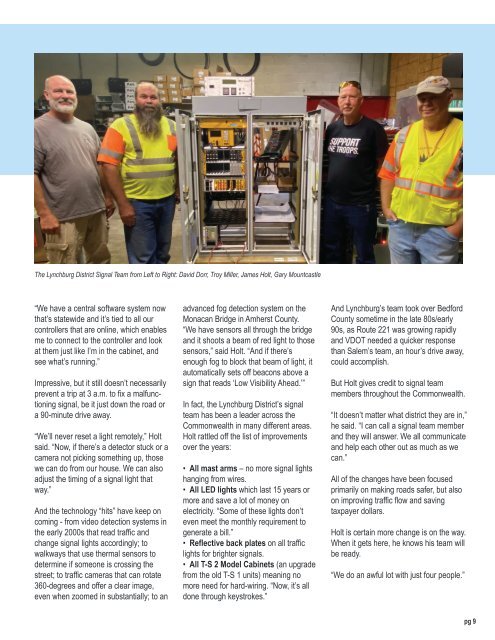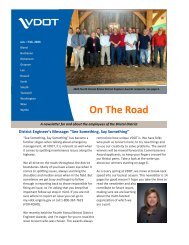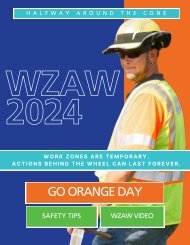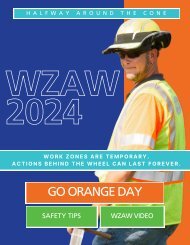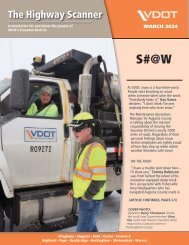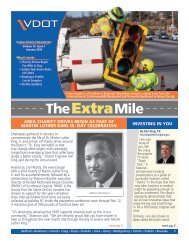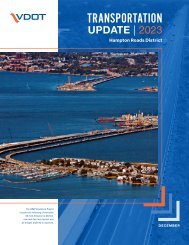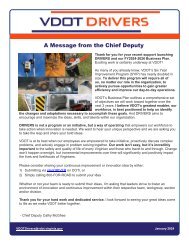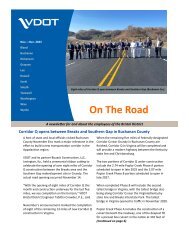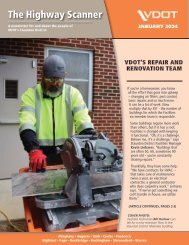Create successful ePaper yourself
Turn your PDF publications into a flip-book with our unique Google optimized e-Paper software.
<strong>The</strong> <strong>Lynchburg</strong> District Signal Team from Left to Right: David Dorr, Troy Miller, James Holt, Gary Mountcastle<br />
“We have a central software system now<br />
that’s statewide and it’s tied to all our<br />
controllers that are online, which enables<br />
me to connect to the controller and look<br />
at them just like I’m in the cabinet, and<br />
see what’s running.”<br />
Impressive, but it still doesn’t necessarily<br />
prevent a trip at 3 a.m. to fix a malfunctioning<br />
signal, be it just down the road or<br />
a 90-minute drive away.<br />
“We’ll never reset a light remotely,” Holt<br />
said. “Now, if there’s a detector stuck or a<br />
camera not picking something up, those<br />
we can do from our house. We can also<br />
adjust the timing of a signal light that<br />
way.”<br />
And the technology “hits” have keep on<br />
coming - from video detection systems in<br />
the early 2000s that read traffic and<br />
change signal lights accordingly; to<br />
walkways that use thermal sensors to<br />
determine if someone is crossing the<br />
street; to traffic cameras that can rotate<br />
360-degrees and offer a clear image,<br />
even when zoomed in substantially; to an<br />
advanced fog detection system on the<br />
Monacan Bridge in Amherst County.<br />
“We have sensors all through the bridge<br />
and it shoots a beam of red light to those<br />
sensors,” said Holt. “And if there’s<br />
enough fog to block that beam of light, it<br />
automatically sets off beacons above a<br />
sign that reads ‘Low Visibility Ahead.’”<br />
In fact, the <strong>Lynchburg</strong> District’s signal<br />
team has been a leader across the<br />
Commonwealth in many different areas.<br />
Holt rattled off the list of improvements<br />
over the years:<br />
• All mast arms – no more signal lights<br />
hanging from wires.<br />
• All LED lights which last 15 years or<br />
more and save a lot of money on<br />
electricity. “Some of these lights don’t<br />
even meet the monthly requirement to<br />
generate a bill.”<br />
• Reflective back plates on all traffic<br />
lights for brighter signals.<br />
• All T-S 2 Model Cabinets (an upgrade<br />
from the old T-S 1 units) meaning no<br />
more need for hard-wiring. “Now, it’s all<br />
done through keystrokes.”<br />
And <strong>Lynchburg</strong>’s team took over Bedford<br />
County sometime in the late 80s/early<br />
90s, as Route 221 was growing rapidly<br />
and VDOT needed a quicker response<br />
than Salem’s team, an hour’s drive away,<br />
could accomplish.<br />
But Holt gives credit to signal team<br />
members throughout the Commonwealth.<br />
“It doesn’t matter what district they are in,”<br />
he said. “I can call a signal team member<br />
and they will answer. We all communicate<br />
and help each other out as much as we<br />
can.”<br />
All of the changes have been focused<br />
primarily on making roads safer, but also<br />
on improving traffic flow and saving<br />
taxpayer dollars.<br />
Holt is certain more change is on the way.<br />
When it gets here, he knows his team will<br />
be ready.<br />
“We do an awful lot with just four people.”<br />
pg 9


